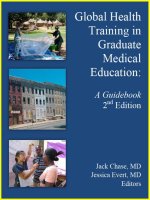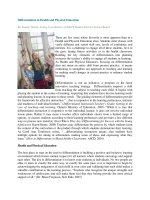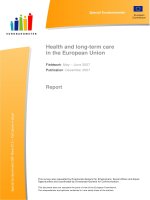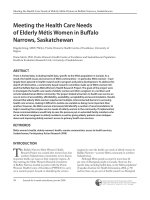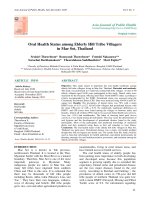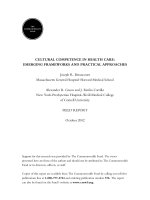Assessment in Health Professions Education pot
Bạn đang xem bản rút gọn của tài liệu. Xem và tải ngay bản đầy đủ của tài liệu tại đây (1.96 MB, 338 trang )
Assessment in Health
Professions Education
The health professions, i.e., persons engaged in teaching, research, administra-
tion, and/or testing of students and professionals in medicine, dentistry,
nursing, pharmacy, and other allied health fields, have never had a
comprehensive text devoted specifically to their assessment needs.
Assessment in Health Professions Education is the first comprehensive text
written specifically for this audience. It presents assessment fundamentals and
their theoretical underpinnings, and covers specific assessment methods.
Although scholarly and evidence-based, the book is accessible to non-
specialists.
• This is the first text to provide comprehensive coverage of assessment in the
health professions. It can serve as a basic textbook in introductory and
intermediate assessment and testing courses, and as a reference book for
graduate students and professionals.
• Although evidence-based, the writing is keyed to consumers of measure-
ment topics and data rather than to specialists. Principles are presented at
the intuitive level without statistical derivations.
• Validity evidence is used as an organizing theme. It is presented early
(Chapter 2) and referred to throughout.
Steven M. Downing (PhD, Michigan State University) is Associate Professor
of Medical Education at the University of Illinois at Chicago and is the
Principal Consultant at Downing & Associates. Formerly he was Director of
Health Programs and Deputy Vice President at the National Board of Medical
Examiners and Senior Psychometrician at the American Board of Internal
Medicine.
Rachel Yudkowsky (MD, Northwestern University Medical School, MHPE,
University of Illinois at Chicago) is Assistant Professor of Medical Education
at the University of Illinois at Chicago. She has been director of the Dr. Allan
L. and Mary L. Graham Clinical Performance Center since 2000, where
she develops standardized patient and simulation-based programs for the
instruction and assessment of students, residents, and staff.
Assessment in Health
Professions Education
Edited by
Steven M. Downing, PhD
Rachel Yudkowsky, MD MHPE
First published 2009
by Routledge
270 Madison Ave, New York, NY 10016
Simultaneously published in the UK
by Routledge
2 Park Square, Milton Park, Abingdon, Oxon OX14 4RN
Routledge is an imprint of the Taylor & Francis Group, an informa business
© 2009 Taylor and Francis
All rights reserved. No part of this book may be reprinted or reproduced
or utilized in any form or by any electronic, mechanical, or other means,
now known or hereafter invented, including photocopying and recording,
or in any information storage or retrieval system, without permission in
writing from the publishers.
Trademark Notice: Product or corporate names may be trademarks
or registered trademarks, and are used only for identi fication and
explanation without intent to infringe.
Library of Congress Cataloging-in-Publication Data
Assessment in health professions education / edited by Steven M. Downing,
Rachel Yudkowsky.
p. ; cm.
Includes bibliographical references and index.
1. Medicine—Study and teaching. 2. Educational tests and measurements.
I. Downing, Steven M. II. Yudkowsky, Rachel.
[DNLM: 1. Health Occupations—education. 2. Educational Measurement—
methods. W 18 A83443 2009]
R834.5.A873 2009
610.71—dc22
2008042218
ISBN 10: 0–8058–6127–0 (hbk)
ISBN 10: 0–8058–6128–9 (pbk)
ISBN 10: 0–203–88013–7 (ebk)
ISBN 13: 978–0–8058–6127–3 (hbk)
ISBN 13: 978–0–8058–6128–0 (pbk)
ISBN 13: 978–0–203–88013–5 (ebk)
This edition published in the Taylor & Francis e-Library, 2009.
To purchase your own copy of this or any of Taylor & Francis or Routledge’s
collection of thouasands of eBooks please go to www.eBookstore.tandf.co.uk.
ISBN 0-203-88013-7 Master e-book ISBN
To my husband Moshe
Looking forward to the next billion seconds and more
To our children Eliezer and Channah
Who bring us much pride and joy
And in memory of our son Yehuda Nattan
May his memory be a blessing to all who loved him
~ RY
Contents
L IST OF F IGURES ix
L
IST OF T ABLES xi
P
REFACE xiii
Steven M. Downing and Rachel Yudkowsky
C HAPTER-SPECIFIC A CKNOWLEDGMENTS xix
1I
NTRODUCTION TO A SSESSMENT IN THE H EALTH
P ROFESSIONS 1
Steven M. Downing and Rachel Yudkowsky
2VALIDITY AND I TS T HREATS 21
Steven M. Downing and Thomas M. Haladyna
3RELIABILITY 57
Rick D. Axelson and Clarence D. Kreiter
4GENERALIZABILITY T HEORY 75
Clarence D. Kreiter
5STATISTICS OF T ESTING 93
Steven M. Downing
6STANDARD S ETTING 119
Rachel Yudkowsky, Steven M. Downing,
and Ara Tekian
7WRITTEN T ESTS: C ONSTRUCTED-R ESPONSE AND
S ELECTED-R ESPONSE FORMATS 149
Steven M. Downing
8OBSERVATIONAL A SSESSMENT 185
William C. McGaghie, John Butter, and Marsha Kaye
9PERFORMANCE T ESTS 217
Rachel Yudkowsky
vii
10 SIMULATIONS IN A SSESSMENT 245
William C. McGaghie and S. Barry Issenberg
11 ORAL E XAMINATIONS 269
Ara Tekian and Rachel Yudkowsky
12 ASSESSMENT P ORTFOLIOS 287
Ara Tekian and Rachel Yudkowsky
L IST OF C ONTRIBUTORS 305
I
NDEX 311
CONTENTSviii
List of Figures
1.1 George Miller’s Pyramid 4
4.1 G Coefficient for Various Numbers of Raters and Stations 86
6.1 Eight Steps for Standard Setting 122
6.2 Hofstee Method 139
6.3 Hofstee Example 141
6.4 Borderline Group Method 143
6.5 Contrasting Groups 144
6.6 Minimizing Passing Errors 144
8.1 Comparison of the Miller Pyramid and Kirkpatrick Criteria
for Learning Outcomes 191
9.1 Miller’s Pyramid: Competencies to Assess with Performance
Tests 218
9.2 Essential Elements of a Standardized Patient Case 222
9.3 Rating Scale Anchors 225
9.4 Sample Rubric for Scoring a Student’s Patient Chart Note 226
9.5 An 8-Station OSCE for an Internal Medicine Clerkship 228
9.6 OSCE Case Example 231
9.7 Construct Underrepresentation 234
9.8 Creating Blueprint Specifications for an OSCE 235
9.9 Some Frameworks to Assist in Blueprinting OSCEs 236
11.1 Miller’s Pyramid: Competencies to Assess with Oral Exams 270
12.1 Kolb’s Experiential Learning Cycle 288
12.2 Miller’s Pyramid: Sample Elements that can be Included in
an Omnibus Assessment Portfolio 290
12.3 Assessment Portfolio Steps 292
ix
List of Tables
1.1 ACGME Toolbox Assessment Methods 10
2.1 Five Major Sources of Test Validity: Evidence Based on
Messick (1989) and AERA, APA, & NCME (1999) 29
2.2 Some Sources of Validity Evidence for Proposed Score
Interpretations and Examples of Some Types of Evidence 30
2.3 Threats to Validity of Assessments 41
3.1 Hypothetical Five-Item MC Quiz Results for 10 Students 63
3.2 Hypothetical Communication Skills Ratings for 200 Students
by Two Judges 67
3.3 Hypothetical Clinical Performance Ratings of 10 Students by
5 Judges/Raters 69
3.4 Spearman Rho Correlations of Rater Agreement 70
4.1 Data for the Example OSCE Measurement Problem:
Ratings from a Piloted Version of the OSCE Examination 78
4.2 G Study Results for Example Problem 81
4.3 D Study Results for Example Problem 85
4.4 ANOVA Table 89
5.1 Types of Scores 94
5.2 Raw Scores, z-Scores, and T-Scores 96
5.3 Item Analysis Example 104
5.4 Correlation of One Test Item Score with Score on the Total
Test 107
5.5 Item Classification Guide by Difficulty and Discrimination 108
5.6 Example of Summary Item Statistics for Total Test 111
6.1 Standard Setting Feedback Questionnaire for Judges 127
6.2 Sample Angoff Ratings and Calculation of Passing Score 134
xi
6.3 Sample Simplified/Direct Angoff Ratings and Calculation of
Passing Score 135
6.4 Sample Ebel Ratings and Calculation of Passing Score 138
6.5 Sample Hofstee Ratings and Calculation of Passing Score 141
6.6 Comparison of Six Standard Setting Methods 146
7.1 Constructed-Response and Selected-Response Item Formats:
Strengths and Limitations 150
7.2 Examples of Constructed-Response and Selected-Response
Items 152
7.3 A Revised Taxonomy of Multiple-Choice Item Writing
Guidelines 158
7.4 Example of Analytic Scoring Rubric for Short-Answer
Essay on the Anatomy of the Inner-Ear 162
8.1 Observational Assessment Goals and Tools 196
8.2 Threats to Validity: In vivo Observational Methods 207
9.1 Threats to the Validity: Performance Tests 232
9.2 Sources of Error in an OSCE 237
10.1 Simulation Based Assessment Goals and Tools 250
10.2 Simulation Based Assessment Planning Steps 254
10.3 Test Blueprint for Clinical Cardiology Using the “Harvey”
CPS 255
11.1 Characteristics of a Structured Oral Exam 273
11.2 Blueprinting and Logistical Decisions 275
11.3 Steps in Examiner Training for a Structured Oral Exam 279
11.4 Threats to Validity: Oral Examinations 282
12.1 Threats to Validity: Portfolios 295
12.2 Portfolios in the Health Professions 301
12.3 Practical Guidelines for Assessment Portfolios 301
LIST OF TABLESxii
Preface
The purpose of this book is to present a basic yet comprehensive
treatment of assessment methods for use by health professions educa-
tors. While there are many excellent textbooks in psychometric theory
and its application to large-scale standardized testing programs and
many educational measurement and assessment books designed for
elementary and secondary teachers and graduate students in educa-
tion and psychology, none of these books is entirely appropriate for
the specialized educational and assessment requirements of the health
professions. Such books lack essential topics of critical interest to
health professions educators and may contain many chapters that are
of little or no interest to those engaged in education in the health
professions.
Assessment in Health Professions Education presents chapters on the
fundamentals of testing and assessment together with some of their
theoretical and research underpinnings plus chapters devoted to spe-
cific assessment methods used widely in health professions education.
Although scholarly, evidence-based and current, this book is intended
to be readable, understandable, and practically useful for the non-
measurement specialist. Validity evidence is an organizing theme and
is the conceptual framework used throughout the chapters of this
book, because the editors and authors think that all assessment data
require some amount of scientific evidence to support or refute the
intended interpretations of the assessment data and that validity is the
single most important attribute of all assessment data.
xiii
The Fundamentals
Chapters 1 to 6 present some of the theoretical fundamentals of
assessment, from the special perspective of the health professions
educator. These chapters are basic and fairly non-technical but are
intended to provide health professions instructors some of the essen-
tial background needed to understand, interpret, develop, and success-
fully apply many of the specialized assessment methods or techniques
discussed in Chapters 7 to 12.
In Chapter 1, Downing and Yudkowsky present a broad overview
of assessment in the health professions. This chapter provides the
basic concepts and language of assessment and orients the reader to
the conceptual framework for this book. The reader who is unfamiliar
with the jargon of assessment or is new to health professions educa-
tion will find this chapter a solid introduction and orientation to the
basics of this specialized discipline.
Chapter 2 (Downing & Haladyna) discusses validity and the classic
threats to validity for assessment data. Validity encompasses all other
topics in assessment and thus this chapter is placed early in the book
to emphasize its importance. Validity is the organizing principle of
this book, so the intention of this chapter is to provide readers with
the interpretive tools needed to apply this concept to all other topics
and concepts discussed in later chapters.
Chapters 3 and 4 both concern reliability of assessment data, with
Chapter 3 (Axelson & Kreiter) discussing the general principles and
common applications of reliability. In Chapter 4, Kreiter presents the
fundamentals of an important special type of reliability analysis,
Generalizability Theory, and applies this methodology to health
professions education.
In Chapter 5, Downing presents some basic information on the
statistics of testing, discussing the fundamental score unit, standard
scores, item analysis, and some information and examples of practical
hand-calculator formulas used to evaluate test and assessment data in
typical health professions education settings.
Standard setting or the establishment of passing scores is the
topic presented by Yudkowsky, Downing, and Tekian in Chapter 6.
PREFACExiv
Defensibility of absolute passing scores—as opposed to relative or
normative passing score methods—is the focus of this chapter,
together with many examples provided for some of the most common
methods utilized for standard setting and some of the statistics used to
evaluate those standards.
The Methods
The second half of the book—Chapters 7 to 12—cover all the basic
methods commonly used in health professions education settings,
starting with written tests of cognitive knowledge and achievement
and proceeding through chapters on observational assessment,
performance examinations, simulations, oral exams and portfolio
assessment. Each of these topics represents an important method
or technique used to measure knowledge and skills acquisition of
students and other learners in the health professions.
In Chapter 7, Downing presents an overview of written tests of
cognitive knowledge. Both constructed-response and selected-
response formats are discussed, with practical examples and guidance
summarized from the research literature. Written tests of all types are
prevalent, especially in classroom assessment settings in health profes-
sions education. This chapter aims to provide the instructor with the
basic knowledge and skills needed to effectively test student learning.
Chapter 8, written by McGaghie and colleagues, overviews obser-
vational assessment methods, which may be the most prevalent
assessment method utilized, especially in clinical education settings.
The fundamentals of sound observational assessment methods are
presented and recommendations are made for ways to improve these
methods.
Yudkowsky discusses performance examinations in Chapter 9.
This chapter provides the reader with guidelines for performance
assessment using techniques such as standardized patients and
Objective Structured Clinical Exams (OSCEs). These methods are
extremely useful in skills testing, which is generally a major objective
of clinical education and training at all levels of health professions
education.
PREFACE xv
High-tech simulations used in assessment are the focus of Chapter
10, by McGaghie and Issenberg. Simulation technology is becoming
ever more important and useful for teaching and assessment, espe-
cially in procedural disciplines such as surgery. This chapter presents
the state-of-the art for simulations and will provide the reader with
the tools needed to begin to understand and use these methods
effectively.
Chapters 11 and 12, written by Tekian and Yudkowsky, provide
basic information on the use of oral examinations and portfolios.
Oral exams in various forms are used widely in health professions
education worldwide. This chapter provides information on the
fundamental strengths and limitations of the oral exam, plus some
suggestions for improving oral exam methods. Portfolio assessment,
discussed in Chapter 12, is both old and new. This method is cur-
rently enjoying a resurgence in popularity and is widely applied in all
levels of health professions education. This chapter presents basic
information that is useful to those who employ this methodology.
Acknowledgments
As is often the case in specialized books such as this, the genesis and
motivation to edit and produce the book grew out of our teaching and
faculty mentoring roles. We have learned much from our outstanding
students in the Masters of Health Professions Education (MHPE)
program at the University of Illinois at Chicago (UIC) and we hope
that this book provides some useful information to future students in
this program and in the many other health professions education
graduate and faculty development programs worldwide.
We are also most grateful to all of our authors, who dedicated time
from their over-busy professional lives to make a solid contribution to
assessment in health professions education.
We thank Lane Akers, our editor/publisher, at Routledge, for his
encouragement of this book and his patience with our much delayed
writing schedule. We also wish to acknowledge and thank all our
reviewers. Their special expertise, insight, and helpful comments have
made this a stronger publication.
PREFACExvi
Brittany Allen, at UIC, assisted us greatly in the final preparation of
this book and we are grateful for her help. We also thank our families,
who were most patient with our many distractions over the long time-
line required to produce this book.
Steven M. Downing
Rachel Yudkowsky
University of Illinois at Chicago, College of Medicine
July 2008
PREFACE xvii
Chapter-specific Acknowledgments
Chapter 2 Acknowledgments
This chapter is a modified and expanded version of two papers which
appeared in the journal, Medical Education. The full references are:
Downing, S.M. (2003). Validity: On the meaningful interpretation of
assessment data. Medical Education, 37, 830–837.
Downing, S.M., & Haladyna, T.M. (2004). Validity threats: Over-
coming interference with proposed interpretations of assessment
data. Medical Education, 38, 327–333.
Chapter 5 Acknowledgments
The author is grateful to Clarence D. Kreiter, PhD for his review of
this chapter and helpful suggestions.
Chapter 6 Acknowledgments
This chapter is an updated and expanded version of a paper that
appeared in Teaching and Learning in Medicine in 2006:
Downing, S., Tekian, A., & Yudkowsky, R. (2006). Procedures for
establishing defensible absolute passing scores on performance
examinations in health professions education. Teaching and Learn-
ing in Medicine, 18(1), 50–57.
xix
The authors are grateful to the publishers Taylor and Francis for
permission to reproduce here material from the paper. The original
paper is available at the journal’s website www.informaworld.com.
Chapter 7 Acknowledgments
The author is most grateful to Thomas M. Haladyna, PhD for his
review of and constructive criticisms and suggestions for this chapter.
Chapter 12 Acknowledgments
Our thanks to Mark Gelula, PhD for reviewing this chapter and for
his helpful comments and suggestions.
CHAPTER-SPECIFIC ACKNOWLEDGMENTSxx
1
INTRODUCTION TO ASSESSMENT
IN THE
HEALTH PROFESSIONS
S
TEVEN M. DOWNING AND
RACHEL YUDKOWSKY
Assessment is defined by the Standards for Educational and Psychological
Testing (AERA, APA, & NCME, 1999, p. 172) as: “Any systematic
method of obtaining information from tests and other sources, used to
draw inferences about characteristics of people, objects, or programs.”
This is a broad definition, but it summarizes the scope of this book,
which presents current information about both assessment theory and
its practice in health professions education. The focus of this book
is on the assessment of learning and skill acquisition in people, with
a strong emphasis on broadly defined achievement testing, using a
variety of methods.
Health professions education is a specialized discipline comprised
of many different types of professionals, who provide a wide range of
health care services in a wide variety of settings. Examples of health
professionals include physicians, nurses, pharmacists, physical therap-
ists, dentists, optometrists, podiatrists, other highly specialized tech-
nical professionals such as nuclear and radiological technicians, and
many other professionals who provide health care or health related
services to patients or clients. The most common thread uniting the
health professions may be that all such professionals must complete
highly selective educational courses of study, which usually include
practical training as well as classroom instruction; those who success-
fully complete these rigorous courses of study have the serious
responsibility of taking care of patients—sometimes in life and death
situations. Thus health professionals usually require a specialized
1
STEVEN M. DOWNING AND RACHEL YUDKOWSKY2
license or other type of certificate to practice. It is important to base
our health professions education assessment practices and methods on
the best research evidence available, since many of the decisions made
about our students ultimately have impact on health care delivery
outcomes for patients.
The Standards (AERA, APA, & NCME, 1999) represent the con-
sensus opinion concerning all major policies, practices, and issues in
assessment. This document, revised every decade or so, is sponsored
by the three major North American professional associations con-
cerned with assessment and its application and practice: The American
Educational Research Association (AERA), the American Psycho-
logical Association (APA), and the National Council on Measurement
in Education (NCME). The Standards will be referenced frequently
in this book because they provide excellent guidance based on the best
contemporary research evidence and the consensus view of educational
measurement professionals.
This book devotes chapters to both the contemporary theory of
assessment in the health professions and to the practical methods
typically used to measure students’ knowledge acquisition and their
abilities to perform in clinical settings. The theory sections apply to
nearly all measurement settings and are essential to master for those
who wish to practice sound, defensible, and meaningful assessments
of their health professions students. The methods section deals specif-
ically with common procedures or techniques used in health profes-
sions education—written tests of cognitive achievement, observational
methods typically used for clinical assessment, and performance
examinations such as standardized patient examinations.
George Miller’s Pyramid
Miller’s pyramid (Miller, 1990) is often cited as a useful model or
taxonomy of knowledge and skills with respect to assessment in health
professions education. Figure 1.1 reproduces the Miller pyramid,
showing schematically that cognitive knowledge is at the base of a
pyramid upon which foundation all other important aspects or fea-
tures of learning in the health professions rests. This is the “knows”
INTRODUCTION TO ASSESSMENT 3
level of essential factual knowledge, the knowledge of biological pro-
cess and scientific principles on which most of the more complex learn-
ings rest. Knowledge is the essential prerequisite for most all other
types of learning expected of our students. Miller would likely agree
that this “knows” level is best measured by written objective tests, such
as selected- and constructed-response tests. The “knows how” level of
the Miller pyramid adds a level of complexity to the cognitive scheme,
indicating something more than simple recall or recognition of fac-
tual knowledge. The “knows how” level indicates a student’s ability to
manipulate knowledge in some useful way, to apply this knowledge,
to be able to demonstrate some understanding of the relationships
between concepts and principles, and may even indicate the student’s
ability to describe the solution to some types of novel problems. This
level can also be assessed quite adequately with carefully crafted writ-
ten tests, although some health professions educators would tend to
use other methods, such as oral exams or other types of more subject-
ive, observational procedures. The “knows how” level deals with cog-
nitive knowledge, but at a somewhat more complex or higher level
than the “knows” level. The first two levels of the Miller pyramid are
concerned with knowledge that is verbally mediated; the emphasis
is on verbal-type knowledge and the student’s ability to describe this
knowledge verbally rather than on “doing.”
The “shows how” level moves the methods of assessment toward
performance methods and away from traditional written tests of know-
ledge. Most performance-type examinations, such as using simulated
patients to assess the communication skills of medical students, dem-
onstrate the “shows how” level of the Miller pyramid. All such per-
formance exams are somewhat artificial, in that they are presented in
a standard testing format under more-or-less controlled conditions.
Specific cases or problems are pre-selected for testing and special
“standardized patients” are selected and trained to portray the case
and rate the student’s performance using checklists and/or rating
scales. All these standardization procedures add to the measurement
qualities of the assessment, but may detract somewhat from the
authenticity of the assessment. Miller’s “does” level indicates the
highest level of assessment, associated with more independent and
STEVEN M. DOWNING AND RACHEL YUDKOWSKY4
free-range observations of the student’s performance in actual patient
or clinical settings. Some standardization and control of the assess-
ment setting and situation is traded for complete, uncued authenticity
of assessment. The student brings together all the cognitive know-
ledge, skills, abilities, and experience into a performance in the real
world, which is observed by expert and experienced clinical teachers
and raters.
Miller’s pyramid can be a useful construct to guide our thinking
about teaching and assessment in the health professions. However,
many other systems or taxonomies of knowledge structure are also
discussed in the literature. For example, one of the oldest and most
frequently used taxonomies of cognitive knowledge (the “knows” and
“knows how” level for Miller) is Bloom’s Cognitive Taxonomy
(Bloom, Engelhart, Furst, Hill, & Krathwohl, 1956). The Bloom
Cognitive Taxonomy ranks knowledge from very simple recall or rec-
ognition of facts to higher levels of synthesizing and evaluating factual
knowledge and solving novel problems. The Bloom cognitive tax-
onomy, which is often used to guide written testing, is discussed more
thoroughly in Chapter 7. For now, we suggest that for meaningful and
successful assessments, there must be some rational system or plan to
Figure 1.1 George Miller’s Pyramid (Miller, 1990).
